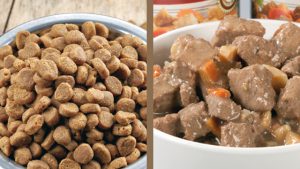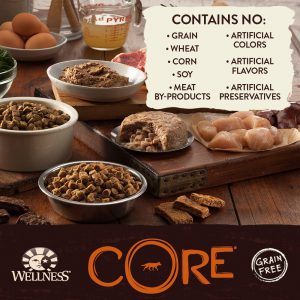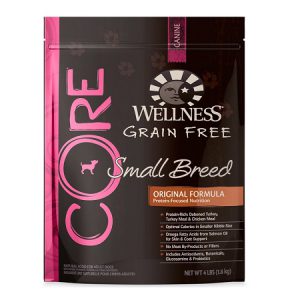Organic or Commercial Dog Food
Wet Is Better Than Dry (Kibble)

All pet parents share the same concern in determining the benefits of organic dog food compared with commercial dog food. Which one is better? Actually, any organic dog food is much better than the commercial dog food because of some factors that will be mentioned below. It is imperative, that all dog owners feed their dogs with the best possible food which will provide the pet with a healthier body and longer life. This is what organic natural foods fed to your dog on a regular basis will do.
Organic dog food does not contain any pesticides, fillers, artificial colors, and GMO’s which are totally bad for humans and your dog too. Generally, these dog foods do not contain sufficient vitamins, protein, minerals, and fiber your pet needs daily to maintain a healthy body. Because some commercial dog foods may lack some of these nutrients, your dog, over time, may become obese by having to eat more food to make up for this deficiency, which is not healthy.
Pet parents really have no option in feeding their pets with the best possible food and organic is the way to go.
Benefits of Organic Dog Food Topics
Just select or click on the topic of interest where more information will be shared about that topic.
- History of Dry (Kibble) Dog Food
- Effects of Pet Food
- Dry, Wet or Raw
- Major benefits of Wet and Raw Dog Food
- What To Look For In Dog Food
- How To Determine Protein Content In Dog Food
- Feeding Your Dog
- Shop Now
History of Dry (Kibble) Dog Food
Dry dog food came into existence due to World War II. Before the war, pet food was only in cans. With the war came rationing. Metal was in short supply, and the government mandated that pet food was non-essential.
Pet Food companies did not want to go out of business, so they figured out how to ‘bake process‘ the canned food and put it into bags. This was only going to be temporary until the war was over. When the war ended, the pet food companies discovered that people thought dry dog food was great! It was easy and convenient, and they could leave it out in a bowl all day and it did not smell or get rancid.
As expected, the companies did not stop making dry pet food after the war was over. They made both canned and dry dog food. However, over time, they discovered how to provide dry kibble pet food to consumers at a reduced cost at the expense of having less nutritional value in the food. Now, pet parents have to be excellent shoppers to know which companies pet food is actually best for their pets.
Commercial dog food adds inexpensive fillers, preservatives and by-products in the manufacturing of the food. These will be noted in the ingredient label on the package. With soaring rates of canine diabetes and cancers, you need to make sure you know exactly what is going into your dog’s food.
Benefits of Organic Dog Food Topics
Effects of Pet Food

The effects of pet food can be devastating to your pet’s overall health. Pet parents must be aware of what is being put into the bag of dog food being purchased at the store. You must become familiar with the dog food labels and the ingredients used in manufacturing the dog food.
Some ingredients must be avoided in feeding them to pets as they can have serious health effects over time. Several dog food ingredients have been found to be harmful but have not yet been addressed by the loosely regulated pet food agencies. These ingredients include:
- Any artificial coloring
- Any artificial flavoring
- Ammoniated lgycyrrhizin
- Bone meal
- Butylated hydroxytoluene (bht)
- Chicken by-products
- Corn syrup
- Digest of poultry by-products
- Dried animal digest
- Dried liver digest
- Ethoxyquin
- Fish by-products
- Fish meal
- Liver glandular meal
- Meat by-products
- Potassium sorbate
- Poultry by-products
- Poultry by-product meal
- Propyl gallate
- Propylene glycol
- Sodium nitrate
- Sucrose
The above ingredients are for all types of dog food whether is raw, dry (kibble) or wet (canned).
Benefits of Organic Dog Food Topics
Dry, Wet or Raw
There are some benefits in both the dry, wet and raw dog food. It all depends basically on the budget you have available for feeding your pet.
Dry
Dry dog food known as kibble in the industry. It is baked and the major concern of pet owners is this process removes some of the nutritional value out of the food. Therefore, it will cost a lot less to feed your dog this type of food over time. Dry kibble must be stored in air-tight containers to extend the life of the food. Dry kibble exposed to air will in time become rancid, which is not edible for your dog to consume.
Dry kibble (usually has between 10% to 20% moisture) is where you may find some of the ingredients that should be avoided as manufactures use them to provide dog food at the lowest possible cost to the consumer. At the same time, this type of pet food has less nutritional value as they use fillers and other bad ingredients going into the food. It is always best to read the label on the packaging before buying.
Manufacturers are now aware that some pet owners want to feed their pets with healthful and nutritional dog food. Some are providing organic dry kibble which will contain much more nutrition than commercial non-organic dog food. However, this kibble will be more expensive, and you must make adjustments to your pet’s food budget.
Even adding water to the dry kibble does not return the food to its original nutritional value.
Dry kibble is always less expensive than wet or raw dog food.
Benefits of Organic Dog Food Topics
Wet

Wet dog food comes in cans. This type of dog food is generally what dogs used to eat in the wild. This type of dog food contains anywhere from 70% to 87% moisture and contains meat which is what they ate in the wild. Again, the pet owner must be aware of conventional and organic canned dog food.
In general, all organic canned dog food will be more expensive than conventional canned dog food. The reason being is the ingredients used to manufacture the dog food will be coming from organic sources. Organic dog food must meet certain standards verses non-organic dog food.
Not all canned dog food is equal, and the pet owner must read the label before purchasing. Providing your dog with wet organic dog food, will improve the overall health of the pet. There is more nutritional value in organic than non-organic dog food. Also, cost will play a role in the way you will proceed.
We highly recommend feeding dogs wet dog food verses for the following reasons:
- It’s like what they were used to doing when in the wild.
- Also, canned has more nutritional value verses dry.
A drawback about canned dog food is it must be refrigerated once opened. It also must be used within three days, or it’s spoiled and cannot be fed to your dog.
Note: Some pet owners like to mix dry food with the wet. This is better than just feeding your dog all dry.
Benefits of Organic Dog Food Topics
Raw

Of the three methods of feeding your pet, using the raw dog food method is the best. However, this method may not be suitable to all pets as it depends upon the activity, they do which determines if you can feed raw to your pet. Always purchase organic vegetables, grains and meats when feeding your pet on a raw diet.
When using raw, you should be aware of some things to look out for. They are mentioned below:
- Unless they are extremely fresh, if you decide to introduce fish, rabbit or pork, be sure to cook them first to kill parasites that are often found in these animals.
- Raw bones are great, but do NOT cook them, as cooked bones will soften which increases the likelihood that they will break. The shards from a broken bone can hurt your dog.
- Always cook grains.
- Some vegetables can be served raw, others should be cooked, and some need to be avoided.
- Cooked: Broccoli, Cauliflower, Corn, Green beans, Hard winter squash, Peas, and Potatoes.
- Avoid These: Onions, Rhubarb, Spinach, Swiss chard, and Tomatoes.
- Eaten Raw: Alpha sprouts, Bell peppers, Carrots (can be cooked), Chopped parsley, finely grated beets, finely grated carrots with peel, finely grated zucchini and other soft squash with peel, Fresh corn, and Lettuce and mixed greens.
- Do not overcook the foods as it will destroy many of the beneficial nutrients.
- Any raw or other foods purchased should be certified organic (“organically raised,” “chemical free,” etc.) for their many beneficial aspects over most commercial dog food.
- Be especially careful when serving raw meat to older dogs and sick dogs as their systems may not be able to handle it.
Regardless of what percentage of veggies make up of your dog’s diet, always rinse them thoroughly with water before serving them to your pet.
If your dog is experiencing any type of the following diseases, it will require a more careful transition over to the new raw diet. The diseases are discussed below:
- Diabetes: If a dog is on insulin, any change in diet may require a change in the dose of the insulin. If the dog does not want to eat the food as the percent of raw is increased, then the dose of insulin will need to be adjusted accordingly that day. Since the dog’s health is likely to improve on a 100% raw diet, the dose of insulin may need to be decreased. Careful monitoring by the pet owner with a home glucometer or visits to the veterinarian to continue checking the blood sugar levels may need to be done to get the dog regulated on the raw diet.
- Pancreatitis: Overall, a RAW diet is much healthier, but a dog with pancreatitis has a difficult time digesting fat and therefore any diet (raw or cooked) will need to be LOW fat. Also, a raw diet actually contains some of the enzymes needed for digestion, and so raw food will actually be easier for them to digest.
- IBS (Inflammatory Bowel Syndrome): This condition is a chronic issue that requires more fiber and more moisture. So, a raw diet would need to have more cooked vegetables included to adjust to this problem. Adding in canned pumpkin, steamed or canned green beans, zucchini or squash usually works well.
- Chronic Diarrhea: This is another problem that needs to be addressed with the addition of probiotics (acidophilus) to the raw diet. Also consider homeopathic treatment to take care of the underlying illness of the patient.
Note: You should always consult your vet before considering moving your dog to a raw diet as he/she might provide you with some expertise in the process.
When moving your dog from dry to wet, or from dry to raw, and wet to raw, you should do this over a period of seven (7) days. Days 1-2: 75% old 25% new. Days 3-4: 50% old 50% new. Days: 5-6: 25% old 75% new. Day 7: 100% new. If you should notice your dog experiencing problems, slow down the process by adding 2 days to the schedule. Days 1-4, 5-8, 9-12 and day 13 100% going forward.
If your dog is still experiencing any problems, always consult your vet and stop the conversion from the old to new.
Benefits of Organic Dog Food Topics
Major Benefits of Wet and Raw Dog Food
Below are some of the main benefits of wet and raw dog food verses dry kibble.
- Healthier
- Weight Gain Controllable
- More Nutritious
- Satisfying
- What They Used To Do In The Wild
- Organic Dog Foods Are More Nutritious and Healthier Than Commercial
- Reduction of Skin Ailments and Allergies
- Fewer Digestive Disorders
- Stronger Immunity
- Longevity
Organic dog food provides better quality sources of nutritional substances than even the non-organic, premium brands. Organic food doesn’t contain bulk-fillers, so your dog consumes only what it needs to maintain healthy energy levels and life functions.
What must be asked of the pet owner is do these benefits out way using cheaper non-nutritional dog food? The answer should be yes. Why? Your dog’s health should be the most important part of this decision. If it’s not good for you to eat, it’s not good for your pet. You will find that spending a little more money on their food now, will be saved with less costs of vet bills later.

Benefits of Organic Dog Food Topics
What To Look For In Dog Food
- Main ingredient must be listed first on the ingredient list
- Complete, balanced and 100% nutritious ingredients
- Zero potentially harmful ingredients
- Natural or organic ingredients
- Contain no artificial colors, chemical preservatives or by-products
- Ingredients must not have been exposed to antibiotics, herbicides or pesticides
- Contains no “filler” foods (unhealthy food like sugar or corn syrup that takes the place of healthy food)
- Contain no Genetically Modified Organisms (GMO’s)
- Be a canned or raw food (NOT dry)
Benefits of Organic Dog Food Topics
How To Determine Protein Content in Dog Food
This can be very confusing when trying to compare protein values with canned and dry dog food. The simplest method is shown below. For example:
Product A – Canned food guarantees 10% protein and 75% moisture (25% dry matter)
Product B – Dry food guarantees 30% protein and 12% moisture (88% dry matter)
- Canned food: Multiply the guaranteed protein percentage by 4
- For example: 10% protein guaranteed x 4 = 40% dry matter protein
- Dry food: Add 4% to the guaranteed protein percentage
- For example: 30% protein guaranteed + 4% = 34% dry matter protein
In this example, the canned dog food has greater amount of protein than the dry.
Benefits of Organic Dog Food Topics
Feeding Your Dog
When feeding your dog, the serving size is mentioned on the bag or can of the product. These servings are just suggestions on feeding your dog for one day. You must take into account their breed, and exercise activity. Pet parents generally provide enough food for their pets and have to be careful in not overfeeding them. You must be observant to see if your pet is gaining or losing weight.
Puppies need twice as much food than adult dogs. Also, pregnant dogs will also need to eat 2 to 3 times more as well. Be sure to take all of these factors into consideration in the feeding of your dog.
Always be careful not to overfeed your dog. Obesity is a problem and can lead to a health issues for your pet the longer it goes without being treated. Feed less to your dog until the desired weight has been reached. Ask your vet what the proper weight for your breed of dog should be when fully grown. The opposite is true for dogs that are underweight. Be careful not to feed your dog more than 10% of his total caloric intake of treats. This is one of the biggest areas where dogs can become obese.
To determine if your dog is overweight, weigh yourself, and note the number. Next, hold your dog and weigh yourself again and note the number. The difference between the first and second number is the approximate weight of your dog. You can do this each week to determine if your dog is losing or gaining weight and take any necessary corrective action.
Benefits of Organic Dog Food Topics
Shop Now
Below are some of the best organic canned dog foods on the market. Just click on the image or text links below and you will be taken directly to the Amazon product ordering page where you can place your order.
As an Amazon associate, I earn from qualified purchases.
